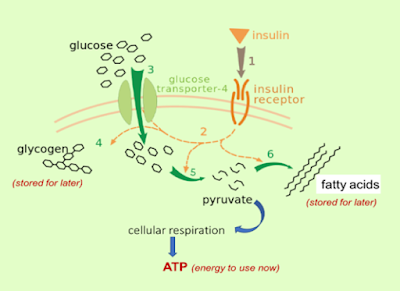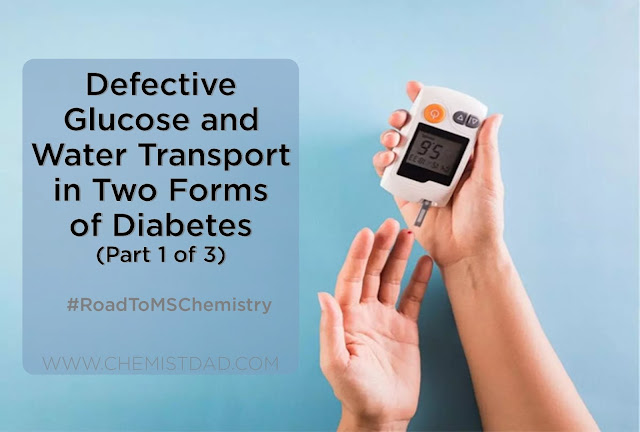Defective Glucose and Water Transport in Two Forms of Diabetes (Part 1 of 3)
Many say that it is better to love men in their 40s. They are much sweeter compared to younger men. This is because many men in their 40s are diabetics. Diabetics are naturally sweet.
Diabetes, as defined by the Center for Disease Control and Prevention or CDCP, is a chronic health condition that affects the body’s ability to transform food into energy (“What Is Diabetes?”). Furthermore, Merriam-Webster defines diabetes as any abnormal condition described by excessive amounts of urine.
What is the Philippines' status when we speak of diabetes?
In 2019, according to International Diabetes Federation, the Philippines ranked 5th in the Western Asia Pacific region in terms of the numbers of diabetes prevalence with 3,993,300 individuals having the said ailment. This will be expected to increase in the next 25 years to about 7.2 million Filipinos. Because of this, Dr. Joven Cuanang considered diabetes to be an epidemic in the country (Baclig).
The common connotation of diabetes is blood sugar. There are two main forms of diabetes: diabetes mellitus and diabetes insipidus. Diabetes mellitus is the one connected with glucose absorption while diabetes insipidus is the condition with water reabsorption in the body.
Diabetes Mellitus
After eating, carbohydrates break into glucose and will stay in the bloodstream. The pancreas will secrete the hormone, insulin. When the insulin reacts with the insulin receptor, it will send a signal to the glucose transporter, GLUT4. GLUT4 is stored in the cell membrane as vesicles. This vesicle will move and fuse with the plasma membrane which will open the membrane at let the glucose enters the cell. Once the insulin level drops, GLUT4 will go back to the cell and will wait until it receives another signal (Nelson).
 |
| Figure 1. shows how the glucose in the blood reached the cell and use as a source of energy. |
When the cell needed energy, the glucose will be metabolized thru cellular respiration and converted to ATP. Otherwise, it will be stored as glycogen in the liver and muscle cells, or as triglycerols or fatty acids in the adipose tissues (“Glucose Regulation and Utilization in the Body”).
If the problem occurs in the absorption of glucose arises, it will be referred Diabetes mellitus. There are 4 types of diabetes mellitus – Type 1, Type 2, gestational, and prediabetes.
If the pancreas is not supplying enough insulin to trigger the GLUT4, it will be called Type 1 diabetes mellitus. This is considered an auto-immune condition where the body mistakenly attacks the insulin in the body resulting in reduced or no secretion of insulin to trigger the GLUT4.
On the other hand, due to several factors, the body may develop insulin resistance and cannot trigger the receptor to signal GLUT4 to do its work. It is referred to as type 2 diabetes mellitus.
See the figures below for the differentiation of type 1 and type 2 diabetes in terms of insulin secretion and receptors.
 |
| Figure 2. Simple differentiation of type 1 and type 2 diabetes mellitus. |
During pregnancy, a woman’s body is subjected to a diverse multitude of hormones and chemical reactions caused by the placenta. Because of this, the body may develop insulin resistance and may increase the blood glucose level. This condition is called gestational diabetes (“Glucose Regulation and Utilization in the Body”).
A person may have an increase in the blood glucose concentration up to the borderline towards the type 2 diabetes (blood glucose of 100-125 mg/dL) this is called prediabetic.
Glycolysis
Glycolysis is the process where glucose molecule is being breakdown and will be used by the cell as a source of energy. The glucose is broken down into pyruvate, a 3-carbon molecule. Upon entering the mitochondrion, this pyruvate will be converted to acetyl CoA which undergoes the Kreb cycle producing carbon dioxide and the high-energy electron carriers NADH2 and FADH2. After an electron transport by NADH2 and FADH2, ATP is released. If the cell has enough energy, the glucose will be used to synthesize glycogen or fat to be stored in the liver (“Glucose Regulation and Utilization in the Body”).
 |
Figure 4. Glycolysis process of breaking down glucose as source of energy (ATP).
|
For the instances that there is not enough glucose in the body, which usually happens during starvation, the protein or the fatty acids will be utilized to produce the energy required by the cell. The protein will be converted to glucose by the process of gluconeogenesis. Fatty acids will be converted to ketones and this will be utilized as a source of energy. Between the two alternative sources of energy, our body will favorably proceed with the fatty acid utilization to conserve the protein (“Glucose Regulation and Utilization in the Body”).
 |
| Figure 5. An illustration of gluconeogenesis (conversion of protein to glucose) and fatty acids to ketones as alternative sources of energy. |
Diabetes prevalence in the Philippines is quite alarming. This only
gives us the warning to keep our health monitored and choose a lifestyle that
will keep us fit.
References:
Baclig, Cristina Eloisa.
“Diabetes: A Bitter Health Crisis for Filipinos.” INQUIRER.Net, 21 July
2021, newsinfo.inquirer.net/1461980/diabetes-a-bitter-health-crisis-for-filipinos.
Bryant, Nia J., et al. “Regulated
Transport of the Glucose Transporter GLUT4.” Nature Reviews Molecular Cell
Biology, vol. 3, no. 4, 2002, pp. 267–77. Crossref, https://doi.org/10.1038/nrm782.
“Diabetes Insipidus and Diabetes
Mellitus.” The Diabetic Voice.Com, www.the-diabetic-voice.com/diabetes-insipidus-and-diabetes-mellitus.html.
Accessed 26 Apr. 2022.
Felman, Adam. “What’s to Know
about Diabetes Insipidus?” Medical News Today, 7 Apr. 2022,
www.medicalnewstoday.com/articles/183251.
“Glucose Regulation and Utilization
in the Body.” Nutrition FN 225,
media.lanecc.edu/users/powellt/FN225OER/Carbohydrates/FN225Carbohydrates5.html.
Accessed 26 Apr. 2022.
“Insulin | Definition, Structure, and
Function.” Encyclopedia Britannica, www.britanica.com/science/insulin.
Nelson, David. Lehninger Principles of Biochemistry.
7th ed., W.H. Freeman, 2017.
Qureshi, Sana, et al. “Diabetes Insipidus: Celebrating a
Century of Vasopressin Therapy.” Endocrinology, vol. 155, no. 12, 2014,
pp. 4605–21. Crossref, https://doi.org/10.1210/en.2014-1385.
Tahrani, Abd A., et al.
“Management of Type 2 Diabetes: New and Future Developments in Treatment.” The
Lancet, vol. 378, no. 9786, 2011, pp. 182–97. Crossref, https://doi.org/10.1016/s0140-6736(11)60207-9.
Vasiljević, Jovana, et al. “The
Making of Insulin in Health and Disease.” Diabetologia, vol. 63, no. 10,
2020, pp. 1981–89. Crossref, https://doi.org/10.1007/s00125-020-05192-7.
“What Is Diabetes?” Centers
for Disease Control and Prevention, 2 Mar. 2022, www.cdc.gov/diabetes/basics/diabetes.html.






No comments:
Post a Comment